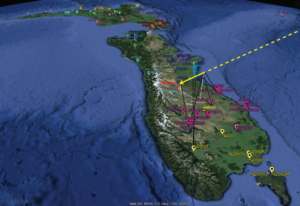What are our goals?
Fireballs Aotearoa represents the public face of New Zealand’s citizen science meteor camera network. Our goals are simple: we seek to find New Zealand’s next meteorite, and we want to find out more about the night sky above us. We try to engage the public and hope to ignite the spark in the next generations, and so the cameras are almost all hosted in schools, observatories and with members of the public. Anyone can join!
 We have no commercial interest in meteorites and any found by Fireballs Aotearoa will be donated to a NZ museum where it can be enjoyed by the public and studied by scientists. We can also facilitate classification of a possible meteorite with the proviso that a portion of it, should it successfully be recognised to be one, be donated to a NZ museum.
We have no commercial interest in meteorites and any found by Fireballs Aotearoa will be donated to a NZ museum where it can be enjoyed by the public and studied by scientists. We can also facilitate classification of a possible meteorite with the proviso that a portion of it, should it successfully be recognised to be one, be donated to a NZ museum.
If you have an interest in taking part: fireballsaotearoa@gmail.com
For possible meteorite classification: meteorites@rasnz.org.nz
I’m interested in joining. What is Fireballs Aotearoa and what are my commitments?
Fireballs Aotearoa oversees the deployment of two meteor camera types and belongs to three meteor networks. The Allsky7 cameras send their data to the Allsky7 Fireball Network and provide beautiful colour videos of the total night sky. The Raspberry PI meteor systems (RMS), which capture portions of the night sky of 88 by 44o in size, send their data each morning to two networks: the Global Meteor Network (GMN) and the NASA Cameras for Allsky Surveillance (CAMS) network.
Most – but not all – Fireballs Aotearoa members host meteor cameras. The operators can participate as much or as little as they like. Some hosts enjoy monitoring the night sky and calibrating fireball trajectories; others are happy with the cameras operating quietly in the background but knowing that they are contributing to a nation-wide citizen science project. Anybody can join.
As indicated on the Get Involved tab, we can sell cameras and will provide support in the installation and maintenance.
What happens to the data that my camera collects?
The data collected by the cameras are globally important because this network is one of the furthest South and densest on the planet. Fireballs Aotearoa has also, for example, provided important new insights into meteor shower behaviour, such as identifying the lambda Sculptorids associated with comet 46P/Wirtanen. The camera data are also regularly used to triangulate fireballs and engage the media, as was the case for the Tekapo/Takapō meteorite.
All observations are automatically gathered. Should there be a fireball event, there is no need for the operator to do anything. The data will have been safely collected, and then – if the event is considered significant enough – can be triangulated by one of the members of Fireballs Aotearoa. Camera operators will be given credit for the use of the data in publications. However, the operators retain complete ability to manage their own data if desired.
In terms of how the data are handled, the continuously active Allsky7 cameras continuously upload data to a cloud server, where they are accessible by the host and that network. However, the live views, along with a variety of information about the system, can be found here: www.allsky7.net.
The RMS cameras operate from dusk to dawn and upload their data each morning to the Global Meteor Network server, with the data then displayed here each morning: (link this to our own map tab). The data are also sent to the Cameras for Allsky Meteor Surveillance (CAMS) network managed by SETI NASA. The data are shown here and contribute to this page here.
Who manages the project?
Fireballs Aotearoa is an affiliation of the public and academics and a designated Section of the Royal Astronomical Society of New Zealand. The network was launched in February 2022, at which time there were 6 RMS cameras across New Zealand. Within a year of a team at the University of Otago taking over production and distribution, there were 77 RMS cameras installed, and a year later 148. This network is now being supplemented with Allsky7 cameras, which can also be built by the team, and provide footage in colour 24/7.
Members of Fireballs Aotearoa do not have to be members of RASNZ, although we strongly encourage joining due to the associated benefits. We are non-commercial and we are all volunteers united in our interest of learning more about New Zealand’s place in space. New members welcome!
Director: Professor James Scott
We can be reached at fireballsaotearoa@gmail.com
Follow us at https://www.facebook.com/FireballsNZ
Report a Fireball
If you have seen a fireball, please click here to tell us about it.
Report a Meteorite
Do you have a rock you think might be a meteorite? Send an email to meteorites@rasnz.org.nz with images and a description of the rock. If you know where and when it was found including that information in the email is helpful too.
Getting in touch with us, including press enquiries
Get in touch with us via e-mail at FireballsAotearoa@gmail.com. Please do not use this address to to report fireballs, use this link to report fireballs.
Web site matters
To report any errors or other matters relating to the web site and its contents please email the web master.